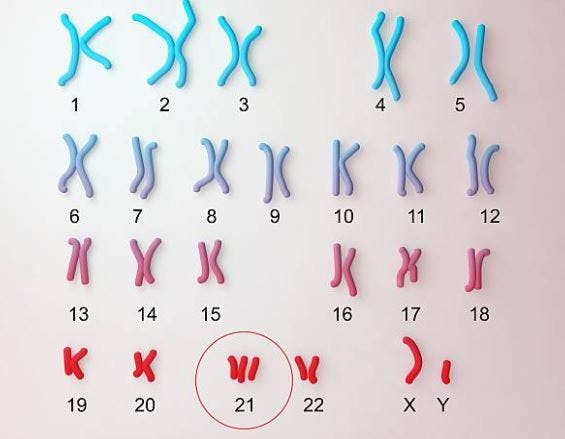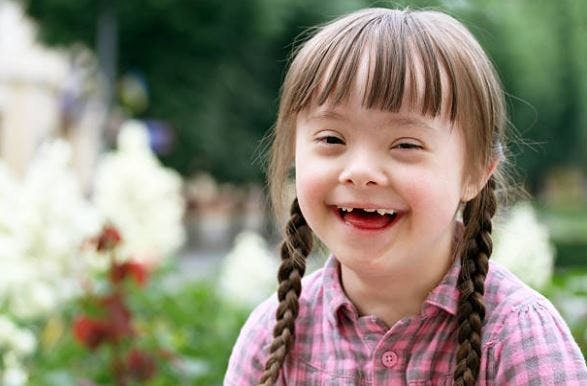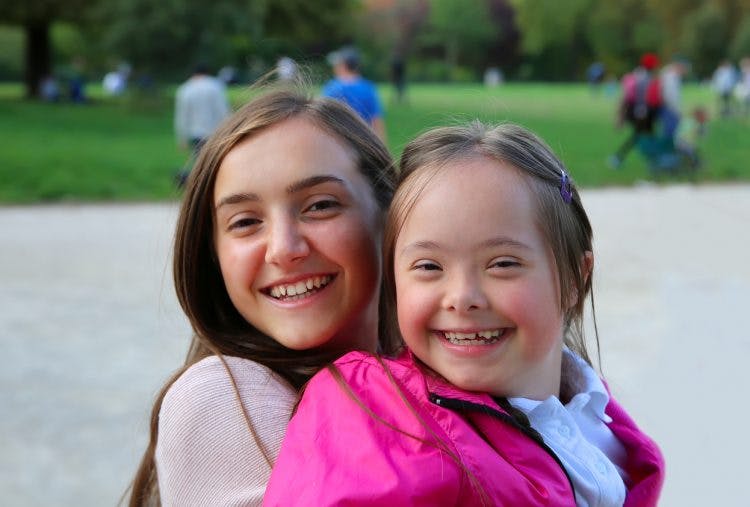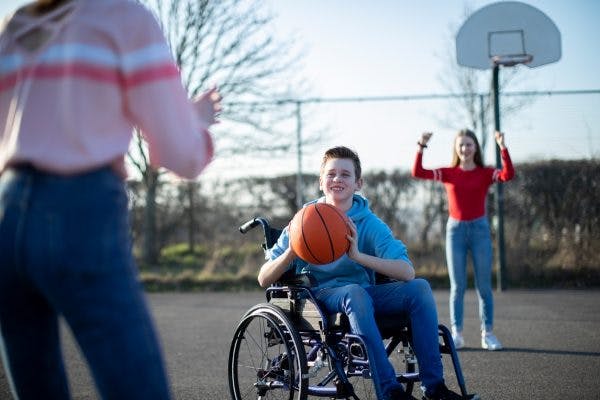Cerebral palsy and Down syndrome are two very different conditions that both occur very early in life. Although rare, it’s even possible to have both conditions.
This article is going to compare cerebral palsy and Down syndrome so that you can better understand the distinctions between the two developmental disabilities.
Let’s get started!
Causes of Cerebral Palsy and Down Syndrome

When a person is born with an extra chromosome 21, they have Down syndrome. Most people are born with 46 chromosomes, but people with Down syndrome have 47.
This extra chromosome affects physical and cognitive development.
Cerebral palsy is a neurological disorder, and Down syndrome is a genetic condition. CP is caused by damage to the brain before, during, or shortly after birth while Down syndrome is caused by abnormal cell division.
While external forces (trauma to the head, labor complications, etc.) can cause cerebral palsy, Down syndrome is strictly determined by genetics.
Cognitive Effects of Cerebral Palsy and Down Syndrome
Intellectual disabilities are a common associative condition of cerebral palsy, but they are not directly related to CP.
Cerebral palsy is strictly a motor disability, meaning that it only directly affects movement.
The prevalence of intellectual disabilities in people with cerebral palsy is about 50%.
In contrast, everyone who has Down syndrome will have some extent of intellectual disability.
Most people with Down syndrome have mild to moderate intellectual disabilities and are very capable of living productively and purposefully.
Because of intellectual disabilities, infants and children with Down syndrome often have developmental delays when it comes to skills like walking and talking.
This does not mean they are incapable of learning; they just need more time to do so.
Physical Features of Cerebral Palsy and Down Syndrome

People with Down syndrome often share physical features like:
- Flat face
- Slanted eyes
- A single crease across the palm
- Short stature
- Small ears, hands, and feet
- Poor muscle tone or loose joints
However, it’s important to understand that everyone experiences Down syndrome differently. Individuals can have all, some, or none of these features.
Unlike Down syndrome, cerebral palsy doesn’t necessarily cause distinct physical features.
It predominantly affects muscle tone. Up to 80% of individuals with cerebral palsy experience high muscle tone (hypertonia), while the remaining 20% experience low muscle tone (hypotonia) or fluctuations between the two.
Therefore, individuals with cerebral palsy may walk with an abnormal gait, have poor posture, difficulties with balance and coordination, or be unable to walk altogether.
Prevalence of Cerebral Palsy vs. Down Syndrome
In the United States, about 1 in every 700 babies is born with Down syndrome, and 2-3 in every 1000 births result in cerebral palsy.
The chances of giving birth to a child with cerebral palsy or Down syndrome are increased in women over 35 years old.
However, it should be noted that just because you’re under 35 does not mean you won’t give birth to a child with Down syndrome or cerebral palsy.
Nearly 80% of infants with Down syndrome are born by women under 35, simply because more women under 35 get pregnant.
Associated Health Problems of Cerebral Palsy and Down Syndrome

Commonly experienced health problems in children with Down syndrome include hearing impairments, vision problems, sleep apnea, and heart defects.
Hearing impairments, vision problems, and sleep apnea are also common associative conditions of cerebral palsy.
While life expectancy is generally unaffected by cerebral palsy, individuals with Down syndrome have a life expectancy of about 60 years.
Additionally, it’s suggested that about 50% of people with Down syndrome develop dementia as they age.
Management for Cerebral Palsy and Down Syndrome
Both cerebral palsy and Down syndrome are lifelong conditions that can be effectively managed to promote an active and fulfilling life.
Because both conditions affect individuals so early in life, seeking early management will ensure that children get the right support for their physical and cognitive needs.
Physical Therapy
Cerebral palsy and Down syndrome can both cause abnormal muscle tone.
At physical therapy, a child with Down syndrome may work on increasing muscle tone by addressing posture and strengthening. A child with cerebral palsy may also work on developing muscle tone, but more likely would be working on managing high muscle tone (spasticity) through stretching or use of orthoses.
For children with either cerebral palsy or Down syndrome, physical therapy will focus on regulating muscle tone for optimal functioning and improving mobility.
Occupational Therapy
At occupational therapy, your child will learn how to be independent in activities of daily living like brushing their teeth, getting dressed, and eating.
Practicing everyday tasks will also improve mobility and self-confidence.
Occupational therapists also address fine motor coordination, which is commonly limited in children with Down syndrome and potentially those with cerebral palsy as well.
Speech Therapy

Because of cognitive delays, many children with Down syndrome have difficulties learning how to speak and use language.
Children with cerebral palsy may not be able to control their oral muscles due to high muscle tone.
Additionally, associated problems like hearing and vision impairments can make it even more challenging to communicate with others.
Speech therapy can help teach your child how to effectively communicate by improving speech clarity, building vocabulary, or exploring alternative forms of communication like sign language or communication boards.
Understanding Cerebral Palsy and Down Syndrome
Cerebral palsy is a motor disability caused by damage to the brain that may co-occur with intellectual disabilities.
Down syndrome is the result of having an additional chromosome 21 which affects both physical and cognitive development.
While cerebral palsy and Down syndrome share some similarities, they are two very different conditions.
Hopefully, this article helped you understand the distinctions between two!











